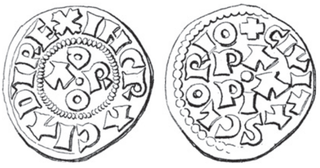Arduino is an Italian masculine name, with variants including Ardovino, Ardoino, Ardolino, Arduilio, Arduo and the feminine Arduina. It derives from the Germanic Hardwin ( Ortwin ), in medieval Italy found in the forms Ardovinus, Ardoinus and Arduinus. In English it is often rendered as Arduin.

Year 955 (CMLV) was a common year starting on Monday of the Julian calendar.

Year 1004 (MIV) was a leap year starting on Saturday of the Julian calendar.

Vigevano is a town and comune in the province of Pavia, Lombardy in northern Italy. A historic art town, it is also renowned for shoemaking and is one of the main centres of Lomellina, a rice-growing agricultural district. Vigevano received the honorary title of city with a decree of Duke Francis II Sforza on 2 February 1532. It is famed for its beautiful Renaissance "Piazza Ducale" in the centre of the town.

Ivrea is a town and comune of the Metropolitan City of Turin in the Piedmont region of northwestern Italy. Situated on the road leading to the Aosta Valley, it straddles the Dora Baltea and is regarded as the centre of the Canavese area. Ivrea lies in a basin that in prehistoric times formed a large lake. Today five smaller lakes — Sirio, San Michele, Pistono, Nero and Campagna — are found in the area around the town.

Berengar II was the King of Italy from 950 until his deposition in 961. He was a scion of the Anscarid and Unruoching dynasties, and was named after his maternal grandfather, Berengar I. He succeeded his father as Margrave of Ivrea around 923, and after 940 led the aristocratic opposition to kings Hugh and Lothair II. In 950 he succeeded the latter and had his son, Adalbert crowned as his co-ruler. In 952 he recognised the suzerainty of Otto I of Germany, but he later joined a revolt against him. In 960 he invaded the Papal States, and the next year his kingdom was conquered by Otto. Berengar remained at large until his surrender in 964. He died imprisoned in Germany two years later.

Arduin was an Italian nobleman who was King of Italy from 1002 until 1014.
Hubert was the illegitimate son of King Hugh of Italy and his concubine Wandelmoda. He became Margrave of Tuscany in 936 and Duke of Spoleto and Margrave of Camerino in 943.

The Kingdom of Italy, also called Imperial Italy, was one of the constituent kingdoms of the Holy Roman Empire, along with the kingdoms of Germany, Bohemia, and Burgundy. It originally comprised large parts of northern and central Italy. Its original capital was Pavia until the 11th century.
Villaverla is a town in the province of Vicenza, Veneto, Italy. It is west of SP349 and south of A31.
The March of Ivrea was a large frontier county (march) in the northwest of the medieval Italian kingdom from the late 9th to the early 11th century. Its capital was Ivrea in present-day Piedmont, and it was held by a Burgundian family of margraves called the Anscarids. The march was the primary frontier between Italy and Upper Burgundy and served as a defense against any interference from that state.

Canavese is a subalpine geographical and historical area of North-West Italy which lies today within the Metropolitan City of Turin in Piedmont. Its main town is Ivrea and it is famous for its castles.
The House of Obertenghi were a prominent Italian noble family of Frankish origin descended from Viscount Adalbert III, first Margrave of Milan.
Ulric Manfred II or Manfred Ulric was the count of Turin and marquis of Susa in the early 11th century. He was the last male margrave from the Arduinid dynasty. Ulric Manfred's daughter, Adelaide, inherited the majority of his property. Through marriage to Adelaide, Otto of Savoy, a younger son of Count Humbert I of Savoy became margrave of Turin. Their descendants would later comprise the House of Savoy who ruled Sardinia and Italy.
Arduin Glaber was count of Auriate from c. 935, count of Turin from c. 941/942, and Margrave of Turin from c. 950/964. He placed his dynasty, the Arduinici, on a firm foundation and established the march of Turin through conquests and royal concessions. The Chronicon Novaliciense, the chronicle of the abbey of Novalesa, is the primary source for his life.
Dado was the Count of Pombia from 967. The comitatus of Pombia, in what is now Northern Italy, included Novara at the time.
The Arduinici were a noble Frankish family that immigrated to Italy in the early tenth century, possibly from Neustria. They were descended from and take their name after one Arduin (Harduoin).
Arnulf II was Archbishop of Milan from 998 to 1018.
Auriate was a county in medieval Italy on the eastern slopes of the Western Alps lying between Cuneo and Saluzzo. The county existed from the late ninth century to the middle of the tenth. The name of the county survives in that of the comune of Valloriate.
Warmund, in Latin Warmundus, was the bishop of Ivrea from about 966 until his death. Warmund is the namesake of the so-called "Warmund Sacramentary", an illustrated manuscript produced for him around the year 1000.
Anscar was a magnate in the Kingdom of Italy who served as Count of Pavia, Margrave of Ivrea (929–36) and Duke of Spoleto (936–40). He is sometimes numbered "Anscar II" to distinguish him from his grandfather, Anscar I of Ivrea. Described by Liutprand of Cremona as courageous and impulsive, he died in the battle of Spoleto.